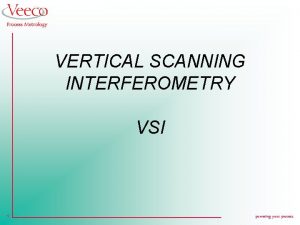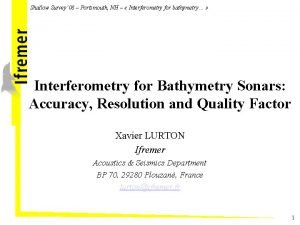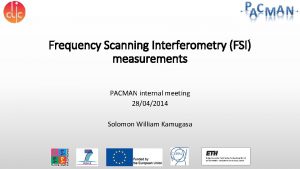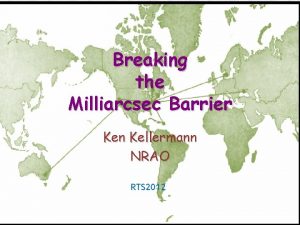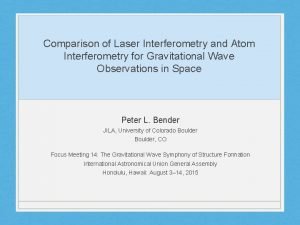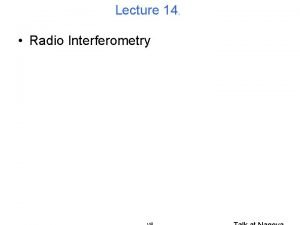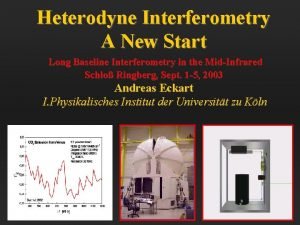VLT Interferometry the milliarcsec view at 2 mm



















- Slides: 19

VLT Interferometry, the milliarcsec view at 2 mm Markus Wittkowski (ESO) In collaboration with: R. Arsenault, Y. Balega, T. Beckert, W. J. Duschl, K. -H. Hofmann, P. Kervella, A. B. Men’shchikov, F. Paresce, D. Schertl, G. Weigelt VLTI and MACAO groups (ESO) “The central parsec of galaxies”, MPIA Heidelberg, 6 -8 Oct. 2004 Markus

VLT Interferometry of galactic centers • Until very recently, observational studies of galactic centers were limited to the diffraction limit of single telescopes, i. e. to about 50 mas at 2 mm, or 4 pc at the distance of NGC 1068. • There a few NIR studies at about this resolution. • Optical to MIR interferometry can reach much higher angular resolution, currently up to the order of 1 -2 mas at 2 mm (0. 71. 4 pc at the distance of NGC 1068), but has until very recently been limited to much brighter targets. • NIR interferometry of GCs requires AO correction (MACAO), and –for many galactic centers- will require a dual feed system (PRIMA) and fast fringe tracking (FINITO). Markus Wittkowski et al. "The central parsec of galaxies ", Workshop at MPIA Heidelberg, 6 -8 Oct 2004

Obtained interferometric observations of (A)GN • Swain et al. (2003) obtained the first NIR long-baseline interferometry of a galactic center with the Keck interferometer: NGC 4151 (Seyfert 1 nucleus), K-band, baseline 85 m. • Jaffe et al. (2004) obtained the first MIR long-baseline interferometry of NGC 1068 (Seyfert 2 nucleus): VLT Interferometer, MIDI instrument. • Wittkowski et al. (2004) obtained the first NIR long-baseline interferometry of NGC 1068: VLT Interferometer, K-band, commissioning instrument VINCI, during MACAO commissioning time, baseline 46 m. Markus Wittkowski et al. "The central parsec of galaxies ", Workshop at MPIA Heidelberg, 6 -8 Oct 2004

Infrared interferometry of (A)GN, modeling • AGN show relatively compact structures, but which are still of the order of , and larger than, the interferometric field of view. • This leads to an uncorrelated flux contribution and a complication of the interpretation. • Even within the interferometric field of view, relatively complex multi-component structures are expected, which are difficult to probe by a usually sparse uv coverage. • Combination with single-telescope data, and coherent modeling (radiative transfer) at multi wavelengths needed. Also more detailed theory for very compact sub-pc structures. Markus Wittkowski et al. "The central parsec of galaxies ", Workshop at MPIA Heidelberg, 6 -8 Oct 2004

The 2 mm view: Structures and scales to be expected Scale (pc) Ang. Scale* (mas) A ~0. 05 ~0. 7 B 1 -2 15 -30 C ~2 -4 ~30 -60 D 10 -100 1501500 *at the distance of NGC 1068 Torus clouds 0. 2 3 Discussion and references in Wittkowski et al. , SPIE 4838, 1378; A&A 418, L 39

The 2 mm view: Effect of scales on visibilities C and D completely obscure any more compact structures. The visibility decreases to zero at B ~ 20 m. B has a flux contribution of 30 %; any more compact strucutures are obscured. A has 10% of the total flux, and B 20%. From Wittkowski et al, SPIE 4838, 1378

Speckle observations at 2 mm Wittkowski et al. , 1998, A&A 329, L 45 Weigelt et al. , 2004, A&A 425, 77 Compact core : ~20 x 40 mas/ 30 x 60 mas , 1. 5 x 3 pc/ 3 x 6 pc, PA ~ -16 deg. Extended comp. : N-S, extension ~ 400 mas, 30 pc (~1 % level of peak intens. ). Markus Wittkowski et al. "The central parsec of galaxies ", Workshop at MPIA Heidelberg, 6 -8 Oct 2004

K-band VLT Interferometry of NGC 1068 • VLTI commissioning observations with the adaptive optics system MACAO of NGC 1068 on Nov. 4, 2003. • Baseline UT 2 – UT 3, 47 m ground length. • Both MACAO systems (on UT 2 and UT 3) could guide on the core of NGC 1068. Same control parameters for both systems. • Interferometric fringes were detected and tracked with the commissioning instrument VINCI in the near-infrared K-band. • 1000 interferograms were recorded on NGC 1068. Fringe frequency 216 Hz. Effective wavelength approx. 2. 18 mm. Wittkowski et al. , 2004, A&A 418, L 39 Markus Wittkowski et al. "The central parsec of galaxies ", Workshop at MPIA Heidelberg, 6 -8 Oct 2004

MACAO-VLTI: Results on UT 2 5 x 5 arcsec 2 K-band image of "Frosty Leo" obtained in 0. 7 arcsec seeing. V~ 11, difficult AO target because 3 arcsec in size at visible wavelengths. The corrected image quality is about FWHM 0. 1 arcsec. Open-loop Close-loop 90 -second K-band exposure of the central 6 x 13 arcsec 2 around the Galactic Center obtained by under average atmospheric conditions (0. 8 arcsec seeing). Although the 14. 6 magnitude guide star is located roughly 20 arcsec from the field center the present image is nearly diffraction limited and has a point-source FWHM of about 0. 115 arcsec.

Visibility results JD -2452940 N B Az m 2 TF V 2 Target 8. 717 250 45. 79 44. 87 0. 054 0. 340 0. 158 +/- 0. 049 NGC 1068 8. 722 214 46. 00 45. 13 0. 062 0. 340 0. 182 +/- 0. 091 NGC 1068 8. 761 407 46. 62 45. 40 0. 319 0. 348 HD 20356 8. 767 438 46. 64 45. 62 0. 304 0. 331 HD 20356 8. 772 416 46. 63 45. 80 0. 315 0. 334 HD 20356 Calibrated squared Vis. : V 2=16. 3 +- 4. 3 % Baseline : B = 45. 84 m Azimuth (east of north) : Az = -44. 9 deg Effectice wavelength Markus Wittkowski et al. : leff = 2. 18 mm "The central parsec of galaxies ", Workshop at MPIA Heidelberg, 6 -8 Oct 2004

Magnitude estimate Observed flux in the photometric outputs of VINCI as a function of the K-band magnitude of several stars observed with the same VLTI/MACAO configuration. This is a difficult calibration because of variable flux coupling, but seems to work alright (see Fig. )! Upper limit for the flux of NGC 1068 in the FOV (might be lower owing to a possible lower performance of MACAO for an extended target as NGC 1068): m. K < 9. 2 +/- 0. 4; FK > 130 +/- 60 m Jy FOV approx. 56 mas (Airy disk of the UTs in K-band). Markus Wittkowski et al. "The central parsec of galaxies ", Workshop at MPIA Heidelberg, 6 -8 Oct 2004

Discussion of the visibility result Assumption of a single Gaussian (not consistent with speckle results): V 2 = 16 % (V~40%) at B = 46 m and leff = 2. 18 mm corresponds to a Gaussian intensity distribution with FWHM of 5. 0 +/- 0. 5 mas ~ 0. 4 +/- 0. 04 pc. Multi-components (consistent with speckle results): At least 40% of the total detected flux (i. e. >50 m. Jy) originates from scales clearly smaller than ~ 5 mas ~ 0. 3 pc (<6. 7 mas at 3 s). The remaining flux originates from scales larger than ~ 5 mas ~ 0. 3 pc but within the ~ 56 mas ~3. 3 pc FOV (speckle component). Markus Wittkowski et al. "The central parsec of galaxies ", Workshop at MPIA Heidelberg, 6 -8 Oct 2004

Discussion of the visibility result Small components: 3 mas / 0. 1 mas. K-band flux of >~ 50 m. Jy originates from scales clearly smaller than ~ 5 mas, 0. 4 pc. • Central source viewed through only moderate extinction (AV 10 ~ AK 1. 2) ? • Substructure of the torus, such as individual clouds forming the torus ? Markus Wittkowski et al. "The central parsec of galaxies ", Workshop at MPIA Heidelberg, 6 -8 Oct 2004

Substructure of the torus • The inner edge of the torus is likely of the order of ~ 2 pc (in diameter), e. g. Dopita et al. 1998. This is rather consistent with the ~ 30 -50 mas ~ 2 -4 pc K-band speckle component (Wittkowski et al. 1998, Weigelt et al. 2004; also Weinberger et al. 1999, AO results). • Since the work of Krolik and Begelmann (1988) it has been discussed that the dusty torus may not have a uniform shape but may consist of a large number of clouds/clumps. See Nenkova et al. 2002, Vollmer et al. 2004). • The radius of single clouds may be ~0. 1 pc (Vollmer et al. 2004) which would be consistent with the observed scale. • Such clouds can also exist in polar direction. • Also free electrons above and below the BLR could scatter light and could form a sub-pc K-band structure. Markus Wittkowski et al. "The central parsec of galaxies ", Workshop at MPIA Heidelberg, 6 -8 Oct 2004

Central source • A fraction of the K-band photons originating directly from the central engine could reach us directly through only moderate extinction. (AV~10, AK~1. 2) (Wittkowski et al. 1998). • The chance for low extinction toward the central source is even larger with a concept of a clumpy torus. • The separated compact component should then show a Seyfert 1 spectrum. • K-band flux from the central engine is possible (see e. g. Wittkowski et al. 1998; Beckert & Duschl 2002; Weigelt et al. 2004) Markus Wittkowski et al. "The central parsec of galaxies ", Workshop at MPIA Heidelberg, 6 -8 Oct 2004

Comparison to VLTI MIDI results of NGC 1068 • Jaffe et al. (2004): 2 components: hot component, T > 800 K, 0. 8 x (<1) pc warm component, T ~ 320 K, 2. 5 x 4 pc • The warm component has a similar size as the compact Kband speckle component (1. 3 x 2. 8 pc/ 2 x 4 pc). • The hot component has a similar size as the very compact KBand VLTI component (<0. 4 pc). • Emission mechanism unlikely to be the same, especially for the warm component. Scattering at electrons ? Markus Wittkowski et al. "The central parsec of galaxies ", Workshop at MPIA Heidelberg, 6 -8 Oct 2004

Comparison to K-band Keck observations of NGC 4151 • K-band interferometric Keck observations of NGC 4151 (Swain et al. 2003, Ap. J 596, L 163) resulted in a calibrated V 2 of 0. 84 +- 0. 06 at baseline of B= 82. 7 m, indicating that most of the flux (~90%) originates from scales smaller than 0. 1 pc in diameter. Their preferred interpretation is emission from an unresolved central accretion disk. • The VLTI/VINCI observations of NGC 1068 are also consistent with thermal emission from a central accretion disk, but with larger contributions from larger resolved components (60%) than for NGC 4151 (10%) of the total flux in the FOV. • This difference might be explained by the different inclination angle, i. e. the Sy 1 and Sy 2 natures of these AGN. Markus Wittkowski et al. "The central parsec of galaxies ", Workshop at MPIA Heidelberg, 6 -8 Oct 2004

Next steps (NIR) • More baselines -> this resolves easily the uncertainty regarding the size of the very compact component (torus substructure vs. central source). • Visibility spectra in JHK with resolution ~1000. -> detailed modeling (radiative transfer) of the torus -> separation of the flux of the central source, if any, and modeling of its spectrum. • Comparison of GCs with different orientations, luminosities, levels of activity, etc. • Comparison of GCs at different redshift. • Consistent modeling of the whole nuclear region, and simultaneous comparison to interferometric data at JHK, and N, as well as to single telescope data. • Coordinated VLBA and ALMA observations ? Markus Wittkowski et al. "The central parsec of galaxies ", Workshop at MPIA Heidelberg, 6 -8 Oct 2004

VLTI Observing Periods – past, present, future • Shared risk science operations with the near-infrared K-band commissioning instrument VINCI in P 70 and P 71 (2002). • MIDI and AMBER Science Demonstration Program (since 2003). • MIDI and AMBER GTO program (since 2003) • Open time in P 73 (2004): 2 UT baselines, SM/VM, MIDI with prism (R~30). 30 proposals received, out of which 20 could be scheduled (12 in service mode and 8 in visitor mode). Catg. B, C, and D. Most OBs successfully completed and data delivered. • Open time in P 74 (2004/5): 3 UT baselines, SM/VM, MIDI with prism and grism (R~230). 30 proposals received, of which again ~20 have been scheduled. • Open time in P 75 (2005): MIDI as in P 74, all 6 UT baselines. Proposal deadline was 1 October 2004. • Later (2005+). AMBER, 2 ATs, FINITO; 4 ATs, PRIMA. Next Cf. P: 1 March 2005; Proposal deadline : 1 April 2005. Markus Wittkowski et al. "The central parsec of galaxies ", Workshop at MPIA Heidelberg, 6 -8 Oct 2004
 Silent aryan warriors
Silent aryan warriors 1-4 inverses of functions
1-4 inverses of functions Vertical scanning interferometry
Vertical scanning interferometry Interferometry
Interferometry Biolayer interferometry 原理
Biolayer interferometry 原理 Frequency scanning interferometry
Frequency scanning interferometry Tư thế ngồi viết
Tư thế ngồi viết Gấu đi như thế nào
Gấu đi như thế nào Thẻ vin
Thẻ vin Thế nào là giọng cùng tên?
Thế nào là giọng cùng tên? Thơ thất ngôn tứ tuyệt đường luật
Thơ thất ngôn tứ tuyệt đường luật Các châu lục và đại dương trên thế giới
Các châu lục và đại dương trên thế giới Từ ngữ thể hiện lòng nhân hậu
Từ ngữ thể hiện lòng nhân hậu Khi nào hổ mẹ dạy hổ con săn mồi
Khi nào hổ mẹ dạy hổ con săn mồi Thế nào là hệ số cao nhất
Thế nào là hệ số cao nhất Diễn thế sinh thái là
Diễn thế sinh thái là Vẽ hình chiếu vuông góc của vật thể sau
Vẽ hình chiếu vuông góc của vật thể sau Slidetodoc
Slidetodoc Làm thế nào để 102-1=99
Làm thế nào để 102-1=99 Lời thề hippocrates
Lời thề hippocrates


